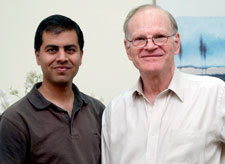This story was published in the Dataquest Magazine and is about an amazing couple from the US, the Binfords, who decided to not only make India there home, but also dstart up a venture in India that promises to revolutionize the way devices read human inputs…. (http://www.dqindia.com/content/Innovator/2007/107031701.asp)
*************************
Reading a Bright Future
Towards the late nineteenth century, William John Warner, a young Irishman, traveled extensively through the length and breadth of India to study the ancient Indian art of astrology. He purportedly visited a lot of Brahmins in North India, studying extensively from the ancient manuscripts possessed by them. Later on, he went to create his own sect of astrology, and was known to the world as Cheiro or Count Louis Hamon.
A century or so later, their was another person who landed on the Indian soil. But this time he was not here for knowledge, rather fashioning it from here. It was the time when the ‘world had not yet been flattened’ and ‘tiger was just a cub’, when Prof Thomas O Binford decided to shift to India bag and baggage. For over three decades, Binford, a leading researcher in image analysis and computer vision, was at the Stanford University as a professor of computer science (Research). In 2000, when he retired from Stanford, Binford decided to don the hat of an entrepreneur and work on a startup. Since, he would be funding the startup from his retirement fund, he had to be quite discerning about how and where he invests the money and that is where India comes into the picture.
Handwriting Recognition Engine
Around the same time India was emerging in the global consciousness, thanks to the Y2K success. Binford decided to take a risk, and in 2001 shifted to India with his wife (a former manager at HP). Settling down in Bangalore, Binford floated Read-Ink Technologies in the space of handwriting recognition. Read-Ink is currently building handwriting recognition technology that could be used in tablet PCs to mobile PDAs that use the stylus. A whole lot of companies across the world have been trying to solve this issue. “The case is fairly simple, every individual has a unique handwriting much like his fingerprint. How can computers decipher it? How can it be digitized? We are trying to solve this problem,” says Binford. 
The company is close to building a high accuracy recognition engine for handwriting and printed text. Based on this, organizations across the globe can automate their data capture process. According to Binford, the engine is going to be launched in the market soon, and already has generated considerable interest in the market.
“We are currently in the prototype stage and working on the alpha version. Hopefully by the middle of the year the product will be launched,” he says. Read-Ink has close to 20 engineers that are currently working with Binford. “Most of them are IIT graduates, highly motivated and raring for a challenge,” he adds.
For the professor the biggest source of support has been his wife, Ione. She is the CEO of Read-Ink and takes care of all the operational issues, like managing the team, marketing, etc. She even runs a small all-night accounting back-office service for American customers. “It is a small service with few clients. It helps us to cover the cost,” she says. Surprisingly, Ione does not think much of the cultural shift. “Since, I am basically from Brazil, India seems quite like home, except probably the infrastructure is much better in Brazil,” she adds gingerly.
A few years into the venture, the Binfords made acquaintance with Pankaj Jain, a Stanford University and IIT Delhi alumnus. Jain was just back from a stint in the fabled Bay Area and was planning to do something on his own. He had earlier worked with Oracle and Seibel in the US. It was after the interaction that Jain and the Binfords launched another venture, Taxila Labs.
Named after the ancient university in modern day Afghanistan, Taxila Labs is working at developing a solution that makes vast amount of information available on mobile phones both through voice and data, thereby making mobile phones as potent as the PC.
“By using the technology developed by us, companies like retailers and service providers can build storefronts and portals that consumers can access on mobile phones and discover the relevant items with ease. These storefronts and portals provide the same choice that is available over the web through a PC and thus enable the Long Tail economies on the mobile phone,” says Jain. The company is very close to finalizing deals with a few companies in India and would be commercially launching the product soon.
“We intend to run and test this technology first in the Indian marketplace, before taking it to advanced markets like Japan and Korea. Considering the mobile explosion in India, if the technology works well in India, it can work anywhere in the world,” adds Jain.
Till date, the Binfords and Jain have been funding the ventures from their own pocket. They live and work in the same building, saving on rent. The ground floor contains a kitchen and employee dining room as well as the Binfords’ bedroom and employees’ guest rooms. Things might have been a wee bit tough, but they are sure that the technology that they are developing is going to take the market by storm, the way Google and Netscape had done in the Silicon Valley. Like Ione says, “I see a dim light at the end of the tunnel”. The distance seems to be decreasing and the light is getting brighter. Who knows, as in the twentieth century the world learnt palmistry thanks to India (merci Cheiro), probably in the twenty-first century the devices might learn to read handwriting, again courtesy India (merci Binfords).
